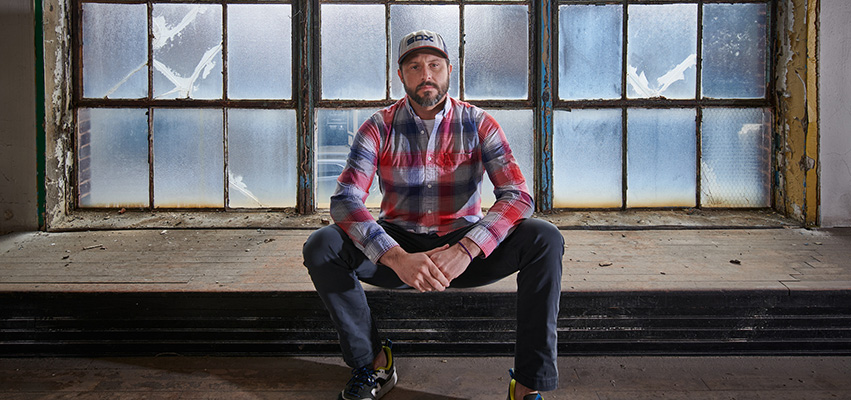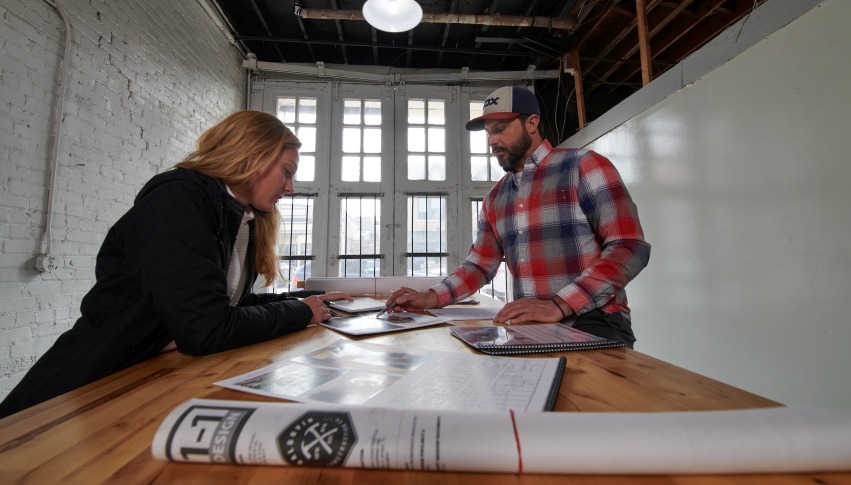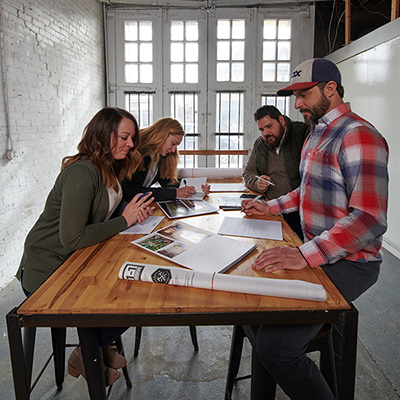
The revitalization of Peoria’s Warehouse District has come a long way since 2010, when Sen. Dick Durbin called it “the most exciting development plan in downstate Illinois.” Following hundreds of millions of investment dollars, multiple buildings restored and renewed, and an abundance of new residential options, a vision that’s been brewing for years is at last being fully realized.
Casey Baldovin is part of a new generation of Peoria developers making his mark on the city. Having made waves with “The Block,” injecting new commercial life into the 1000 block of SW Washington Street, he’s turned his attention to the 800 block of SW Adams, scooping up properties on both sides of the street. Besides bringing more condos and apartments to the area, he intends to carve out a brand-new retail and entertainment corridor—an epicenter of activity in Peoria’s Warehouse District.
Born to Build
Born in San Jose, California, Casey Baldovin grew up in Morton, the son of a union carpenter. He was artistic and athletic, with an eye for design, and construction just came naturally. When he wasn’t playing one sport or another, he was helping his dad on a job site.
He started working for other contractors as a teenager, building houses and learning the trade. Upon graduating high school in 2002, he wasn’t sure what he wanted to do—but “getting a degree or a desk job never really appealed to me,” Baldovin admits. So he gravitated toward what he knew best. “I took my dad’s advice, got into the union and started working for P.J. Hoerr.”
Working for one of Peoria’s premier contractors gave Baldovin the range of experience he would need to advance his career. “I learned everything, but I’m really good at complicated concrete foundation work,” he notes. “Big buildings… bringing them out of the ground, start to finish. I learned a lot there, and it honed my skills for large-scale construction.”
Skateboarding was another creative outlet for Baldovin; he even founded a company to sell his own custom decks. “I’m very business-minded,” he explains. “That gave me the ability to do something of my own… and build a brand.” He founded Baldovin Construction two years later—not just as an umbrella for side work, but as a vehicle for his entrepreneurial dreams.
“I’m just not built to be led by someone else,” Baldovin chuckles. “It pained me every day getting up to go work for somebody else… knowing what I could be growing for myself. So, you just put your time in and try to learn everything you can.”

Call of the Warehouse District
Even before he went out on his own full-time, Baldovin Construction had built a reputation for quality craftsmanship and forward-thinking design. “If people wanted something hip or outside of the box—if you wanted your house to really pop—we’d get a call,” he explains. “So I built a pretty good name and brand off of that.”
As his residential business grew, Baldovin started landing high-profile commercial work as well. “We did a dental office—completely gutted the building and changed the entire look of it. That got us some notoriety,” he recalls. “People saw that we can do really cool work… and we do everything in-house”—design, development and construction. “You don’t have to meet with five different people.”
He and his team designed the interior of Slow Hand Craft BBQ in Peoria Heights and overhauled Childers Eatery on University Street, the quality of which did not go unnoticed. With years of construction experience under his belt, Baldovin was ready to move into development. And Peoria’s Warehouse District had long been calling his name.
“I started looking at these buildings 11 years ago, back when I had the skateboard company,” he says. When he left P.J. Hoerr in 2016, he got started on “The Block”—his introduction to large-scale commercial development. Working with developer Katie Kim of The Kim Group, Baldovin rehabilitated five historic buildings into a destination space anchored by Venue Chisca, a massive wedding and event center. It was a complex project, with a host of learning opportunities along the way.
“I kind of cut my teeth on that development,” Baldovin explains. “I was used to commercial lending, but not at that scale. [Katie] got some tenants down there and gave me some guidance on securing investors. I learned a lot from her.”
As the Warehouse District’s first purely commercial project, The Block’s success was far from certain. “Residential is easy—it just makes sense. The rental market is huge,” Baldovin explains. “But somebody has to take a risk to put in commercial. Some investors were skeptical because they thought it was a little ahead of its time, or that it was too far [south of downtown].” In the end, his bet paid off.
“Venue Chisca has done wonders for getting people down here on the weekend,” Baldovin notes. “It attracts people from out of town too, and that’s what’s huge. And it will only get better.”

Adams and Oak
Since completion of The Block, even more housing options have come online in the Warehouse District. With each project building on the last, new opportunities are opening up on the 800 block of SW Adams, just south of Dozer Park. First there was Sugar Wood-Fired Bistro, which opened in late 2013 amidst a sea of vacant storefronts and a smattering of artist studios. Then came Zion Coffee Bar and Rambler, an outdoor clothing shop, in early 2017. Soon the entire block will be bursting with activity.
Last November, Casey Baldovin purchased the historic Federal building at 800 SW Adams and the adjoining Mitchell Fabrics building at 810 SW Adams. Located across the street from Zion, the Federal is a veritable fortress—more than a century old and impeccably maintained for its age. At seven stories high, it’s the tallest building in the Warehouse District, offering prime views of the river and cityscape. In its shadow, the Mitchell Fabrics building stretches horizontally along Adams Street. It is this pair of buildings that comprise Baldovin’s recently announced Adams and Oak project, an anchor of his plans for the neighborhood.
Ninety to 100 high-end apartments are proposed for the Federal building, overlooking a bustling mix of retail shops, restaurants and entertainment-based businesses. The details are fluid, as Baldovin tosses out concepts for private patios, rooftop lofts, even a swimming pool—“a lot of cool amenities,” he states. “If we get enough interest, then we’ll do it.”
Pre-leasing started at the end of January, and the first residents are expected to move in next year. Baldovin himself will be among them. “I’m going to live in Federal as soon as we can get an apartment done,” he declares.
Even as residents move into the Federal building, phased renovations will be taking place on the ground. “We have some really good commercial tenants,” he notes. “So we’re going to start on that while we’re doing the residential, and get them open as soon as we can.” He hints at a ”restaurant/distillery type deal” and alludes to streetside seating and a variety of rooftop amenities, but the details have yet to be made public. “We’re looking to break ground in early summer,” Baldovin adds.

Inside the Center
Across Adams Street, Crafted DIY Studio & Bar is gearing up to open its doors next to Rambler, with a helping hand from Baldovin. “We designed the interior and exterior, the loft upstairs, and now we’re fixing the building up,” he explains. “That’ll be a pretty cool place.”
Immediately to its south, the William F. Grawey Building sprawls across 809 – 833 SW Adams, its multiple additions over the years swallowing up a majority of the block. For decades it was home to Grawey’s auto parts company, while its second floor once featured a bowling alley—at one time the largest in downstate Illinois. Amidst extended vacancies in recent years, the building housed a variety of short-lived ventures: a dinner theater, a dance club, an archery range and dozens of artist studios.
It’s now home to the offices of Baldovin Construction and Baldovin Development, with exciting plans to come. Baldovin’s original vision for The Block—a large, multi-vendor marketplace modeled after the Milwaukee Public Market—will instead come to life beneath the barrel roof in the rear of the Grawey building, with additional commercial space available ranging from 1,000 to 8,000 square feet. They’re calling it “The Center,” a mix of restaurants, retail and residential.
“I believe this building is the center of the Warehouse District,” Baldovin asserts. “We’re talking to a lot of different people—a bakery, a BBQ joint, a deli… We’ve got a couple of cool restaurants, a graphic design shop, a potential brewery, a popsicle/ice cream shop and some other specialty retailers.”
He envisions space for more than a dozen vendors in the marketplace, which will serve as a low-overhead incubator for small businesses that can’t afford a large retail storefront. “We’ll help them get in and get their feet wet,” Baldovin explains. Five emerging restaurateurs are already on board, and he hopes to get them up and running this fall. Meanwhile, some suggest that a supermarket in the building could solve this area’s larger food desert problem.
On the second floor, Baldovin has plans for 26 apartments, ranging from studios to one- and two-bedroom units—and he may even try to bring back a couple of bowling lanes. “The pin setting area is still there,” he notes with a smile. “We have some old photos—it’s cool to see how many people used to pack the house to watch bowling. I’d like to bring that energy back.”
Like the Adams & Oak project, The Center will open in phases, with work ongoing as businesses set up shop. It will require substantial work, Baldovin admits, “but the building has a beautiful, rich history and really good bones—and that’s the big ticket we look for.”

Making the Experience
The stars seem to be aligned for the self-assured former skateboarder, who “leads with the unshakable premise that nothing is impossible,” as the bio on his company’s website reads. For Baldovin, quality is everything. “Quality is the number-one most important thing,” he insists. “I’m here to make sure that we do these buildings right—that we get the community where it needs to be.” And he has big ideas for what that means.
In the span of minutes, he serves up plans for enormous murals, for projecting movies onto the sides of buildings, for live music in and around the ballpark, for outdoor vendors and large street festivals, and the list goes on… an endless stream of concepts to bring vibrancy to this once-rundown neighborhood. And his plans for string lighting—“across Adams from Oak to Maple, and eventually all the way down to Persimmon”—will make the Warehouse District glow.
“I want this to feel like Washington Avenue in St. Louis,” Baldovin suggests. “Walkable. Lit. I want people to want to come down here, grab a burger and a beer, do some shopping… head over somewhere else, have another drink. I want them to move around, all day and night.” And critical to that objective will be making this part of town family-friendly—“not just bars and restaurants,” he clarifies.
Baldovin ponders plans for an elaborate scavenger hunt, a way to engage kids while their parents shop—essentially turning the Warehouse District into a game. “It would be something to make the buildings interactive,” he affirms. “If I can make a game out of it, maybe their parents would be inclined to stick around a little longer.”
Not all of his concepts will come to fruition, but Baldovin’s willingness to entertain them is a vital part of his well-considered plan. “We have a vision of what we want to see down here,” he explains. “We know who we want to see and what the blend should be. This is going to be the hub.”

The Tipping Point
At age 35, Baldovin is a millennial—the same demographic that Peoria’s revitalized Warehouse District was designed to attract. And recent research suggests the millennial preference for urban living is not wearing off, which bodes well for his vision. As the boomers continue to retire, the younger generations are stepping up to run businesses, and Baldovin’s crew of nearly 30 employees is dominated by them.
Administrative director Michelina Runyon and project manager Nick Schone are fellow millennials, while architectural designer Roxanne Ibe, fresh out of college, is from Generation Z. All have become trusted partners, bringing fresh eyes and a youthful perspective to their work. “We’ve become a great team,” says Baldovin. “It’s like thoroughbreds: you hire a team that you can unbridle and let them run. Tell them your vision and where you want to go—don’t put restrictions on them.”
With the rise of a new generation, their passions and preferences are remaking the rules of the game. “I feel there’s a big change happening in America,” Baldovin declares. “The people in our generation want to spend their money on an experience. They want something they feel like they’ve connected with. Maybe they met the chef or they know the owner… They care about things like that.
“I love that [small retailers] like Rambler are coming back,” he continues. “The big box stores had 50 or 60 years, but their reign is over.” Nowhere can that shift be seen more clearly than in Peoria’s Warehouse District, where dreams of a bustling “Wrigleyville” have been bandied about since Dozer Park first opened in 2002. These dreams date back even further to the late 1990s, when developer Pat Sullivan first staked out the riverfront. It required decades of small steps, complex economic incentives and muscling through the Great Recession. But to the patient observer, it appears 2020 could well be a tipping point.
With his bold vision and a record of execution, Casey Baldovin is sure to be leading the way, proving the naysayers wrong. “A lot of people are very negative on this community,” he says, shaking his head. “They don’t realize how much good there actually is, and what you can do.
“These districts are what makes people get interactive, and that’s what we need if we want to change the stigma about Peoria,” he adds. “This area is where everybody is going to want to be. It’s going to have the most stuff to do. It’s going to be very cool.”
For his part, Baldovin is relentlessly positive, confident in his ability to make a meaningful difference. “It starts with pride and it’s across the board,” he declares. “Take pride in your work; take pride in where you live… and people will want to be a part of it.
“That’s where you start,” Baldovin finishes. “And that is what changes everything.” PM
- Log in to post comments

